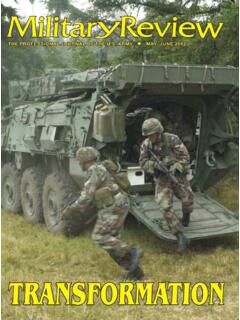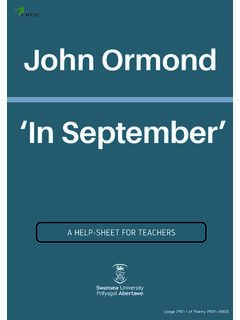Transcription of Heuristics and Biases in Military Decision Making
1 58 Mission Command Military REVIEWM ajor Blair S. Williams, Army, is a Joint planner at Strategic Com-mand. He holds a from the Military Academy (USMA), an from the University of Missouri, and a from Harvard University. He has served in a variety of command and staff positions, including deployments to Iraq and Afghanistan, as well as an assignment as an assistant professor of economics in the Department of Social Sciences at USMA. _____PHOTO: Army SSG Clarence Washington, Provincial Reconstruc-tion Team Zabul security forces squad leader, takes accountability after an indirect fire attack in Qalat City, Zabul Province, Afghanistan, 27 July 2010.
2 ( Air Force photo/SrA Nathanael Callon)If we now consider briefly the subjective nature of war the means by which war has to be fought it will look more than ever like a gamble .. From the very start there is an interplay of possibilities, probabilities, good luck, and bad that weaves its way throughout the length and breadth of the tapestry. In the whole range of human activities, war most closely resembles a game of cards. Clausewitz, On War. 1 CARL VON CLAUSEWITZ S metaphoric description of the condition of war is as accurate today as it was when he wrote it in the early 19th century. The Army faces an operating environment characterized by volatility, uncertainty, complexity, and Military professionals struggle to make sense of this paradoxical and chaotic setting.
3 Succeed-ing in this environment requires an emergent style of Decision Making , where practitioners are willing to embrace improvisation and theory of reflection-in-action requires practitioners to question the structure of assumptions within their professional Military commanders and staff officers to willingly try new approaches and experiment on the spot in response to surprises, they must critically exam-ine the Heuristics (or rules of thumb ) by which they make decisions and understand how they may lead to potential bias. The institutional nature of the Military Decision Making process (MDMP), our organizational culture, and our individual mental processes in how we make decisions shape these Heuristics and their accompanying Biases .
4 The theory of reflection-in-action and its implications for Decision Making may sit uneasily with many Military professionals. Our established doctrine for Decision Making is the MDMP. The process assumes objec-tive rationality and is based on a linear, step-based model that generates a specific course of action and is useful for the examination of problems that exhibit stability and are underpinned by assumptions of technical-rationality. 5 The Army values MDMP as the sanctioned approach for solving problems and Making decisions. This stolid template is comforting; we are familiar with it.
5 However, what do we do when our enemy does not conform to our assumptions embedded in the process? We discovered early in Iraq that our opponents fought differently than we expected. As Heuristics and Biases in Military Decision Making Major Blair S. Williams, ArmyThe author is indebted to COL(R) Christopher Paparone, MAJ Rob Meine, MAJ Mike Shek-leton, and COL(R) Doug Williams for reviewing this article and providing insightful suggestions for its published in the Sep-Oct 2010 issue of REVIEW Mission CommandSPECIAL EDITIONa result, we suffered tremendous organizational distress as we struggled for answers to the insur-gency in Iraq.
6 We were trapped in a mental cave of our own Making and were unable to escape our preconceived notions of Military operations and Decision Fortunately, some have come to see the short-comings of the classical MDMP process. It is ill-suited for the analysis of problems exhibiting high volatility, uncertainty, complexity, and ambiguity. The Army s nascent answer, called Design, looks promising. As outlined in the new version of FM 5-0, Operations Process, Chapter 3, Design is defined as a methodology for applying critical and creative thinking to understand, visualize, and describe complex, ill-structured problems and develop approaches to solve them.
7 7 Instead of a universal process to solve all types of problems (MDMP), the Design approach acknowledges that Military commanders must first appreciate the situation and recognize that any solution will be With Design, the most important task is framing a problem and then reframing it when conditions involves improvisation and on-the-spot experimentation, especially when we face time and space constraints in our operating envi-ronment. FM 6-0, Mission Command, Chapter 6, states, Methods for Making adjustment decisions fall along a continuum from analytical to intui-tive.
8 As underlying factors push the method further to the intuitive side of the continuum, at some point the [planning] methodology no longer applies. 10 In the course of intuitive deci-sion Making , we use mental Heuristics to quickly reduce complexity. The use of these Heuristics exposes us to cognitive Biases , so it is important to ask a number of What Heuristics do we use to reduce the high volatility, uncer-tainty, complexity, and ambiguity, and how do these Heuristics introduce inherent bias into our Decision Making ? How do these Biases affect our probabilistic assessments of future events?
9 Once apprised of the hazards rising from these heuristic tools, how do we improve our deci-sions? This article explores these questions and their implications for the future of Military Decision EconomicsThe examination of Heuristics and Biases began with the groundbreaking work of Nobel Laureate Daniel Kahneman and Professor Amos Tversky. Dissatisfied with the discrepancies of classical economics in explaining human Decision Making , Kahneman and Tversky developed the initial tenets of a discipline now widely known as behav-ioral In contrast to preexisting classi-cal models (such as expected utility theory) which sought to describe human behavior as a rational maximization of cost-benefit decisions, Kahne-man and Tversky provided a simple framework of observed human behavior based upon choices under uncertainty, risk, and ambiguity.
10 They pro-posed that when facing numerous sensory inputs, human beings reduce complexity via the use of Heuristics . In the course of these mental processes of simplifying an otherwise overwhelming amount of information, we regularly inject cognitive bias. Cognitive bias comes from the unconscious errors generated by our mental simplification methods. It is important to note that the use of a heuristic does not generate bias every time. We are simply more prone to induce error. Additionally, this bias is not cultural or ideological bias both of which are semi-conscious Kahne-man and Tversky s identified phenomena have withstood numerous experimental and real-world tests.














